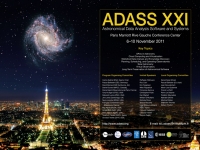Spectro-Perfectionism in SDSS-III
Adam Bolton (The University of Utah), Stephen Bailey (LBNL), Joel Brownstein (U. of Utah), Parul Pandey (U. of Utah), David Schlegel (LBNL), Yiping Shu (U. of Utah)
Abstract
The Baryon Oscillation Spectroscopic Survey (BOSS) of the Sloan Digital Sky Survey III (SDSS-III) is the largest extragalactic spectroscopic survey to date, both in the number of spectra being collected and in the volume of the universe being mapped. BOSS has been delivering survey-quality spectra since December 2009, and is on track to obtain spectra of more than 1.5 million galaxies by mid 2014. While BOSS target galaxies are fainter than the galaxies observed in the original SDSS, the night-sky foreground is as bright as ever. This decreasing signal-to-foreground trend -- which will only be exacerbated in future redshift surveys such as the proposed BigBOSS experiment -- demands a new approach to spectroscopic data analysis. I will describe the results of our ongoing work to implement calibration and extraction of BOSS spectra by forward modeling the projection of photons onto the CCDs through the full two-dimensional spectrograph point-spread function (2D PSF; the ′spectro-perfectionism′ algorithm of Bolton & Schlegel 2010). This work promises to deliver Poisson-limited sky subtraction and lossless propagation of the input spectrum likelihood function given the raw data. I will also describe hardware-design principles motivated by the need for robustness and tractability of 2D PSF extraction within large-scale survey operations, and a ′Bayesian stacking′ method to recover galaxy population distribution parameters given accurate likelihood functions for large samples of low SNR spectra.
Slides in PDF format
Paper ID: O09

